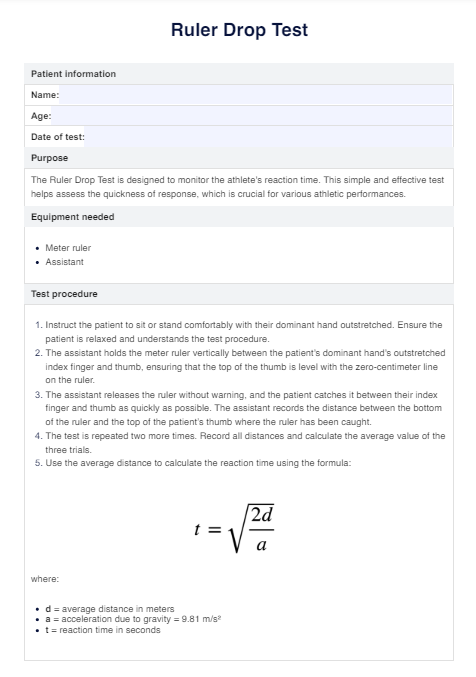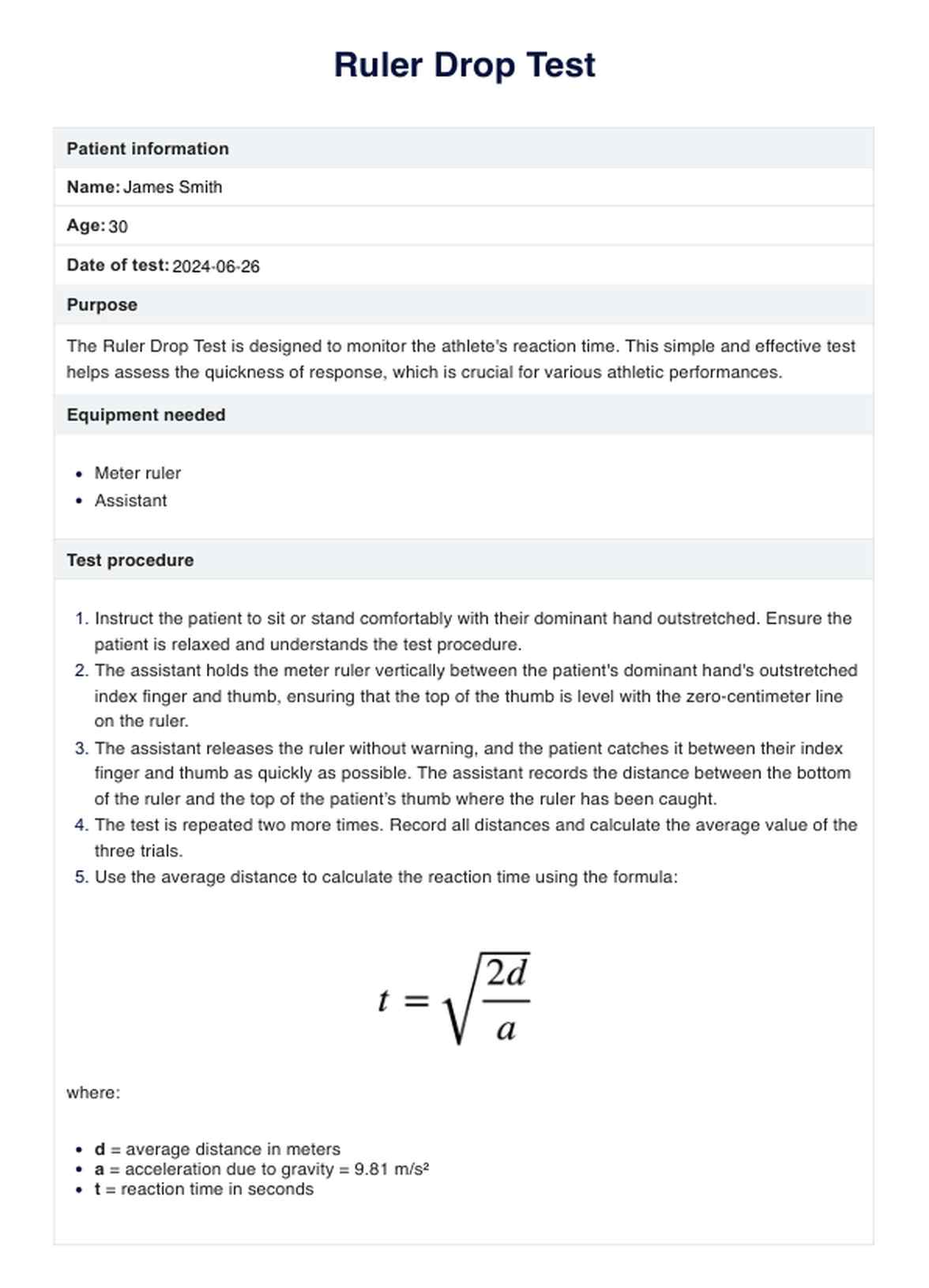Ruler Drop Test
Learn how to use the Ruler Drop Test to assess and improve athlete reaction time with Carepatron's comprehensive sports health software.


What is reaction time?
Reaction time refers to the interval between the stimulus’s presentation and the motor response’s initiation. It is a critical measure of how quickly an individual can respond to a given stimulus, encompassing brain processes, sensory processing, decision-making, and motor response, all coordinated by the nervous system. This measure is essential in everyday activities and crucial in sports and other high-performance activities where quick reactions can mean a significant difference between success and failure.
Several factors can influence an individual's reaction time, including age, gender, physical fitness, and the complexity of the stimulus. One critical element that enhances reaction time is muscle memory, which is developed through repeated assessment and practice. Muscle memory allows movements to become more automatic and less reliant on conscious thought, helping to speed up the response time.
Why is it important for athletes to have good reaction time?
Good reaction time is essential for athletes because it directly impacts performance and safety. Quick reaction times enable athletes to respond rapidly to opponents, changes in the environment, or unexpected events during a game or competition. This responsiveness is crucial in basketball, soccer, tennis, and martial arts, where split-second decisions can significantly influence the outcome.
That's why practicing specific drills can help athletes develop new physical skills, which in turn can improve their reaction times. Additionally, good reaction time helps avoid injuries by allowing athletes to react swiftly to potential hazards or collisions.
Health issues and injuries that impact reaction time
Several health issues and injuries can adversely affect reaction time. Here are some specific factors that impact reaction time:
- Arthritis: Limits joint mobility, slowing physical reactions.
- Concussions: Impair cognitive function, leading to slower motor responses.
- Neurological disorders: Conditions like multiple sclerosis and Parkinson's disease disrupt nerve signaling.
- Musculoskeletal injuries: Sprains, strains, and fractures restrict movement and delay responses.
- Chronic conditions: Diabetes affects nerve function, resulting in slower reactions.
- Vision impairments: Reduce the ability to detect and respond to stimuli quickly.
- Fatigue and sleep disorders: Lower overall cognitive and motor performance.
Ruler Drop Test Template
Ruler Drop Test Example
What is the Ruler Drop Test?
The Ruler Drop Test is a simple and effective method of assessing an individual’s reaction time. It is one of the most commonly used reaction time tests. It measures reaction time and tests how quickly a person can respond to a visual stimulus by catching a falling ruler. This test is widely used due to its ease of administration and minimal equipment requirements.
How is this test conducted?
To conduct the Ruler Drop Test, the patient sits or stands with their dominant hand outstretched, ready to catch a ruler held by an assistant. The test can be conducted using both the left and right hands to compare reaction times. The assistant positions the zero point of the ruler vertically between the patient’s thumb and index finger, with the zero-centimeter mark level with the top of the patient’s thumb. Without warning, the assistant releases the ruler.
The patient catches it as quickly as possible, and the distance the ruler falls before being caught is recorded. This process is repeated three times to ensure accuracy, and the distances are averaged to calculate the reaction time using a specific formula.
How is it scored, and how are the results interpreted?
The Ruler Drop Test is scored by measuring the distance the ruler falls before the patient catches it. This distance is recorded in centimeters for each of the three trials, and the average distance is calculated. The average distance is then used to determine the reaction time, with shorter distances indicating faster reaction times.
The results are interpreted by comparing the reaction time to normative data or previous test results to evaluate improvements or declines in the patient’s reaction speed. This assessment helps tailor training programs and identify areas needing improvement.
How to use our Ruler Drop Test template
The Ruler Drop Test template is a valuable tool for healthcare professionals to efficiently assess and monitor an athlete's reaction time. This section will provide step-by-step instructions on using the template effectively to ensure consistent and accurate clinical test results.
Step 1: Prepare the patient and equipment
Explain the test to the patient to ensure they are comfortable and understand the procedure. Have the patient sit or stand with their dominant hand outstretched, relaxed, and ready. Ensure you have a meter ruler and an assistant to help conduct the test.
Step 2: Position the ruler between the thumb and index finger
Have the assistant hold the meter ruler vertically between the patient's thumb and index finger, ensuring the top of the thumb is level with the zero-centimeter mark on the ruler. This positioning is crucial for maintaining consistency and accuracy.
Step 3: Conduct the test
Instruct the assistant to release the ruler without warning. The patient must catch the ruler between their thumb and index finger as quickly as possible after the ruler falls. Record the distance at which the patient catches the ruler. Repeat this process two more times.
Step 4: Record and calculate the average distance
Record the distances for each of the three trials. Calculate the average distance by summing the three measurements and dividing by three. This average distance will be used to determine the reaction time.
Step 5: Calculate and record reaction time
Calculate the reaction time using the formula provided. Record the reaction time in the designated section on the template.
Benefits of conducting this test
Conducting the Ruler Drop Test offers several benefits for both athletes and healthcare professionals:
Easy to administer
This test requires minimal equipment and can be conducted almost anywhere, making it highly accessible for routine assessments.
Quick assessment
The Ruler Drop Test provides immediate feedback on an athlete’s reaction time, allowing for swift adjustments in training or rehabilitation plans.
Objective measurement
The test yields quantifiable data that can be tracked over time, providing a clear picture of an athlete’s progress and the effectiveness of intervention strategies.
Commonly asked questions
The Ruler Drop Test can be conducted regularly, such as weekly or bi-weekly, to monitor improvements in reaction time and adjust training programs as needed.
Yes, the Ruler Drop Test is suitable for all age groups, though it is most commonly used with athletes and individuals involved in physical rehabilitation.
A good reaction time score typically falls within the range of 15 to 20 centimeters for average adults, though this can vary based on age, fitness, and physical skill level.







































































































